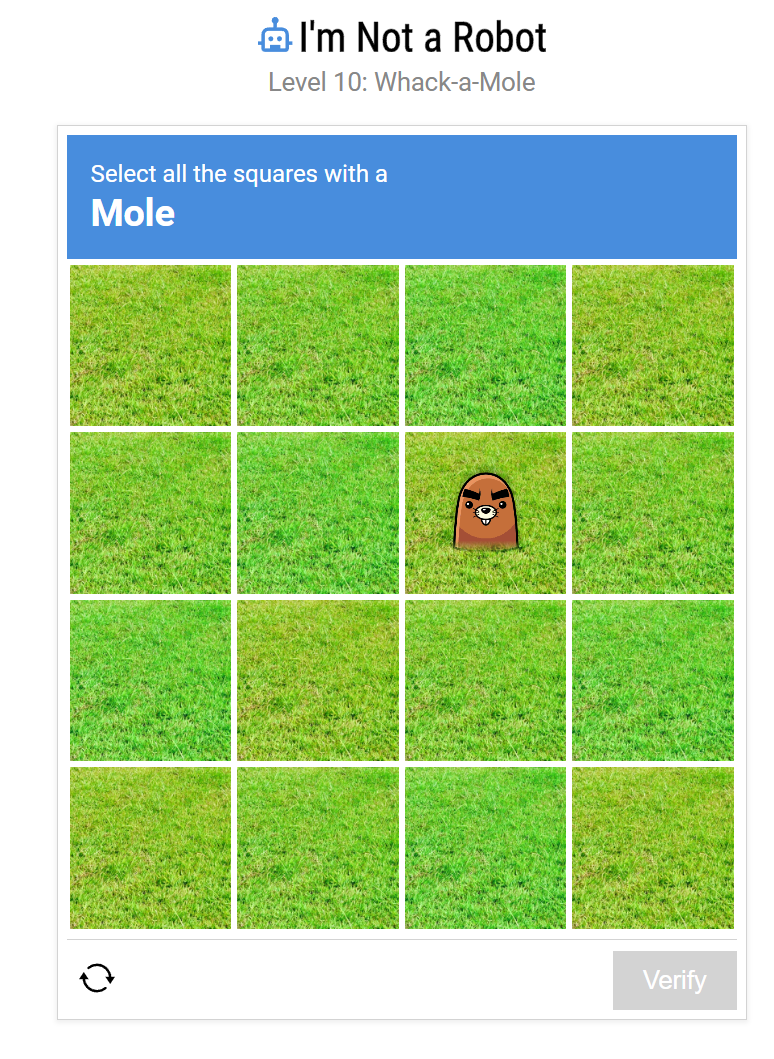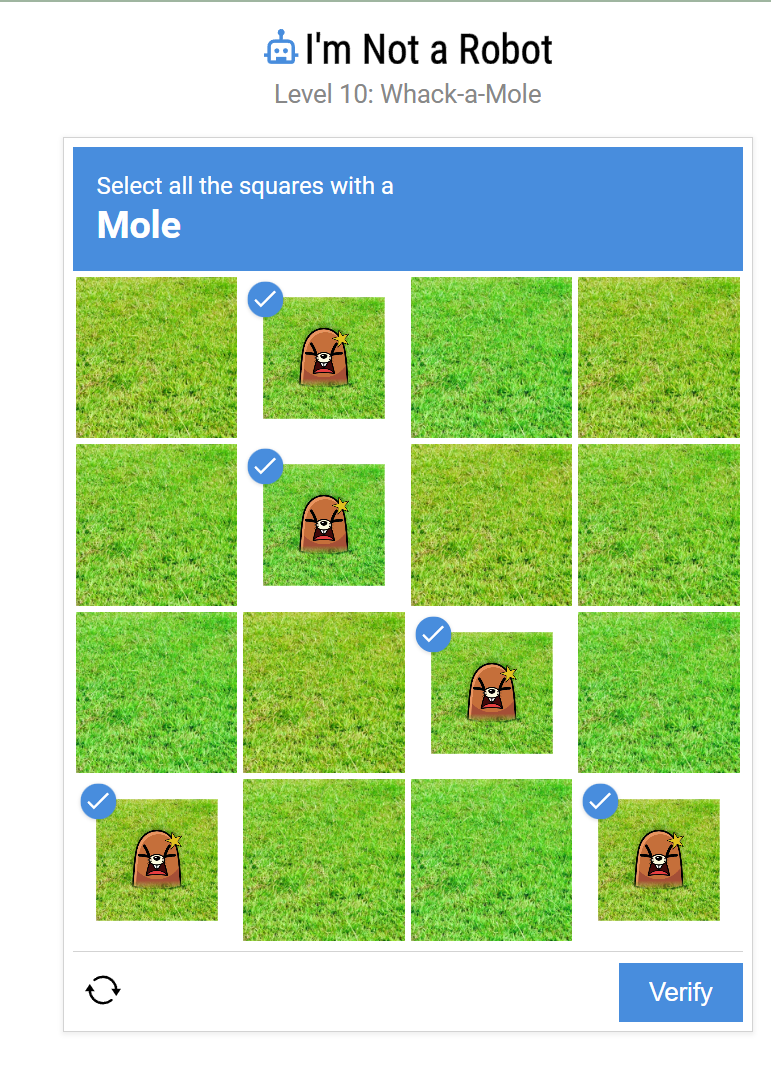How to Beat Level 10 in I'm Not a Robot - Whack-a-Mole Guide
TL;DR
- Objective: Master Level 10 of Neal.Fun's 'I'm Not a Robot' by successfully clicking 5 moles in the whack-a-mole challenge.
- Steps: Scan grid continuously, click moles immediately upon appearance, avoid grass squares, maintain accuracy over speed.
- Target: 5 successful mole hits to activate verification and complete the level.
- Risk: Clicking grass squares wastes time and reduces efficiency; missed moles disappear quickly.
This guide provides a comprehensive approach to conquering Level 10 of Neal.Fun's 'I'm Not a Robot' game, specifically the fast-paced whack-a-mole challenge. Players often struggle with the timing requirements and accuracy demands of this arcade-style puzzle. This article breaks down the challenge into systematic strategies, ensuring optimal reaction time and selection accuracy for successful completion.
Unlocking Level 10: The Whack-a-Mole Reaction Challenge Explained
Level 10 of Neal.Fun's 'I'm Not a Robot' game introduces a dynamic, time-sensitive challenge that tests players' reaction speed, visual scanning ability, and hand-eye coordination. Unlike previous levels that allow deliberate analysis, this puzzle demands immediate responses to rapidly changing visual stimuli. The challenge simulates classic arcade whack-a-mole gameplay while maintaining the anti-bot verification context, requiring players to demonstrate human-like reaction patterns and decision-making speed that would be difficult for automated systems to replicate.

Level 10 Whack-a-Mole Game
Mastering Whack-a-Mole: A Comprehensive Reaction Strategy Guide
The key to successfully navigating Level 10 of 'I'm Not a Robot' lies in developing optimal scanning patterns, maintaining consistent reaction times, and implementing accurate target discrimination under time pressure. The puzzle presents a grid where moles appear randomly and briefly, requiring immediate identification and selection. Follow these detailed strategies to complete the whack-a-mole challenge:
Strategy 1: Optimal Positioning and Preparation Techniques
- Objective: Establish ideal cursor positioning and mental preparation for maximum reaction efficiency.
- Procedure: Position your cursor in the center of the grid to minimize travel distance to any potential mole location. Maintain a relaxed but alert posture with your clicking hand ready for rapid movement. Prepare mentally for sustained attention and quick decision-making. Avoid tension in your hand or arm, as this can slow reaction times and reduce accuracy over the duration of the challenge.
Strategy 2: Advanced Visual Scanning and Pattern Recognition
- Objective: Develop systematic visual scanning techniques to detect mole appearances across the entire grid simultaneously.
- Procedure: Implement peripheral vision scanning rather than focusing on individual grid squares. Train your eyes to detect movement and color changes across the entire visible area. Moles appear as brown creatures emerging from dark holes, creating distinct visual contrast against the green grass background. Develop recognition patterns for mole characteristics: brown coloration, rounded shape, and emergence animation from holes.
Strategy 3: Precision Targeting and Error Management
- Objective: Maximize clicking accuracy while maintaining rapid response times and managing selection errors.
- Procedure: Aim for the center of each mole target to ensure reliable hit registration. When you accidentally click grass squares, immediately click them again to deselect and avoid wasting selections. Maintain focus on mole targets exclusively - grass squares provide no progress toward the 5-mole goal and only consume time and attention. Develop muscle memory for quick, accurate clicking motions.

Level 10 Successful Mole Hits
Strategy 4: Timing Optimization and Completion Management
- Objective: Manage the temporal aspects of mole appearances and optimize completion timing.
- Procedure: Understand that moles have limited appearance duration - typically 1-2 seconds before disappearing. React immediately upon mole detection rather than deliberating on target selection. Track your progress toward the 5-mole target to maintain motivation and focus. Once you achieve 5 successful mole hits, the verification button will activate - click it immediately to complete the level before additional moles distract you.
Advanced Reaction Techniques and Performance Optimization
- Anticipatory Scanning: Develop the ability to predict likely mole appearance locations based on recent patterns, while maintaining comprehensive grid coverage.
- Reaction Time Minimization: Practice rapid visual-to-motor response chains to reduce the delay between mole detection and clicking action.
- Sustained Attention Management: Maintain consistent alertness throughout the challenge duration, avoiding attention lapses that could cause missed opportunities.
- Error Recovery Protocols: Implement quick recovery strategies for missed clicks or accidental grass selections to minimize time loss.
Behind the Challenge: Understanding Human-Computer Interaction Testing
Neal.Fun's Level 10 cleverly implements a classic test of human reaction capabilities that would be challenging for automated systems to replicate convincingly. The whack-a-mole format tests multiple human cognitive and motor functions simultaneously: visual processing speed, pattern recognition, decision-making under time pressure, and fine motor control. These combined requirements create a verification challenge that effectively distinguishes human users from automated bots while providing engaging gameplay.
The challenge serves as both entertainment and education about the principles of human-computer interaction and the design of systems that leverage human cognitive strengths. Real-world applications of similar concepts include reaction time testing in psychological research, user interface responsiveness evaluation, and gaming systems that adapt to player performance characteristics. The puzzle demonstrates how interactive challenges can effectively verify human participation while remaining enjoyable and accessible.
Pro Tips for Conquering Reaction-Based Challenges
Mastering Level 10 and similar reaction-speed puzzles requires developing systematic approaches to rapid visual processing and accurate motor responses. These strategies will improve your performance in time-sensitive, accuracy-dependent challenges.
Tip 1: Develop Peripheral Vision Utilization
- Objective: Maximize your visual coverage of the entire grid without losing focus on individual targets.
- Details: Practice expanding your visual attention to encompass the entire grid simultaneously rather than scanning sequentially. This technique allows you to detect mole appearances anywhere in the grid without the delay associated with sequential scanning. Train your peripheral vision to recognize the distinctive visual signature of mole appearances.
Tip 2: Optimize Click Timing and Accuracy Balance
- Objective: Find the optimal balance between reaction speed and clicking precision.
- Details: While speed is important, accuracy prevents wasted effort on incorrect targets. Develop consistent clicking techniques that prioritize reliable target acquisition over maximum speed. Practice rapid but controlled clicking motions that ensure reliable hit registration while maintaining quick response times.
Tip 3: Implement Systematic Error Correction
- Objective: Minimize the impact of inevitable mistakes through efficient error management.
- Details: When you accidentally click grass squares, immediately deselect them by clicking again. Don't let mistakes disrupt your scanning rhythm or cause frustration that affects subsequent performance. Treat errors as normal parts of the challenge and maintain focus on forward progress.
Tip 4: Manage Cognitive Load and Attention Sustainability
- Objective: Maintain optimal performance throughout the entire challenge duration.
- Details: The whack-a-mole challenge requires sustained attention and consistent reaction performance. Avoid mental fatigue by maintaining relaxed alertness rather than tense concentration. Take brief mental resets between successful hits to maintain peak performance throughout the challenge.
Frequently Asked Questions About Reaction-Speed Challenges
Players often encounter similar difficulties when tackling Level 10's demanding reaction and accuracy requirements. Here are answers to the most common questions:
-
Q1: How can I improve my reaction time for detecting moles?
- A1: Practice peripheral vision scanning and develop recognition patterns for mole visual characteristics. Focus on detecting movement and color changes rather than detailed shape analysis. Regular practice with reaction-time games can also improve your baseline response speed.
-
Q2: What should I do if I keep missing moles because they disappear too quickly?
- A2: Focus on improving your visual scanning efficiency and reducing decision-making delay. Position your cursor centrally and practice immediate clicking upon mole detection. Consider that some missed moles are normal - maintain focus on the ones you can successfully target.
-
Q3: How do I avoid accidentally clicking grass squares when trying to hit moles quickly?
- A3: Develop more precise targeting by aiming for mole centers rather than edges. Practice controlled clicking motions that balance speed with accuracy. When you do click grass accidentally, immediately deselect by clicking again.
-
Q4: Is there a pattern to when and where moles appear?
- A4: Mole appearances are generally random, though you may notice some clustering or timing patterns. Focus on comprehensive grid scanning rather than trying to predict specific appearance locations. Maintain readiness for moles to appear anywhere at any time.
-
Q5: How do I know when I've successfully completed the challenge?
- A5: The verification button will activate once you've successfully clicked 5 moles. Your progress is typically indicated by the number of selected moles, and the interface will change to allow submission once the target is reached.
Final Summary
Successfully completing Level 10 of 'I'm Not a Robot' requires mastering the balance between reaction speed and targeting accuracy in a dynamic, time-pressured environment. The challenge tests your ability to maintain sustained attention, implement rapid visual processing, and execute precise motor responses under temporal constraints. Master this level by developing comprehensive visual scanning techniques, optimizing your reaction-to-action response chains, and maintaining consistent performance throughout the challenge duration. Remember that accuracy and systematic approaches are more effective than frantic clicking, as precise targeting of the 5 required moles is the key to successful completion.